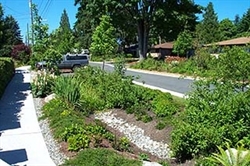
Waggonner and Ball Architects
Effective stormwater management can keep water where it falls, instead of backing up into basements.
I think I’m safe in saying 2015 wasn’t most Illinoisans’ favorite year on record. Between a state budget impasse, a pretty forgettable Bears season (again), and 22K people leaving for greener pastures, it was 365 days that most won’t miss…
…unless you’ve been tracking stormwater management policy and infrastructure. 2015 was a pretty good year for those of us working to mitigate the impacts of increased rainfall and more intense storms. Here are five reasons to not lose all hope.
Reason one: More space
The Metropolitan Water Reclamation District of Greater Chicago’s Thornton Reservoir came online, serving the South Side of Chicago and many southern Cook County suburbs. It’s been a long time coming, but now that the reservoir is fully operational, it will capture lots of stormwater that would otherwise have mixed with sewage and run off into the Cal Sag Channel, Little Calumet River and other area waterways.
All told, it can hold 7.9 billion gallons of water, which is the total volume of 12 Soldier Fields (and given the Bears’ trajectory, we might think about whether filling a 13th Solider Field with combined sewer overflow water would be a better use of that space). Next spring we should see immediate improvements in water quality, as well as reduced flooding. Exciting. If you’re into explosions, check out Metropolitan Planning Council’s (MPC) video of the Last Blast at Thornton, and then see what it looks like in operation.
Reason two: More data
The Ill. Dept. of Natural Resources completed its Urban Flooding Awareness Act Report, a first-of-its-kind effort to examine the cost of basement flooding and sewer backups (as distinct from a river overflowing its banks). One of the hallmarks of the study was the unique access the department had to insurance data from throughout the state, which is typically not readily available to academics or non-government organizations. The verdict? Illinois property owners have seen
“at least $2.319 billion in documented damages between 2007 and 2014, of which $1,240 billion were private claims that typically represent basement flooding and sewer backup. Although the largest percentage of insurance claims is from northeastern Illinois, urban flood damages and problems occur statewide in urban areas.”
The report’s recommendations cover everything from amending insurance rules to updating our precipitation data, and provide a policy change gameplan for the State, MPC and many others.
Reason three: More tools
As an outgrowth of the Calumet Stormwater Collaborative, Delta Institute and Guidon Design, Inc. produced free green infrastructure design templates for the Midwest and Great Lakes region, vetted and designed by experts, and now available online.
Why is this a good thing? Well, for one, consistent design of green infrastructure means we’re steadily on the path toward these bioswales and permeable pavers being regarded as real infrastructure. And two, many of the communities that could benefit the most from green infrastructure solutions for additional stormwater storage, or to reduce demand on existing sewers, simply don’t have a lot of financial leeway. If free design templates can help lower-income communities build more green infrastructure faster, then Delta and Guidon will have a done a very good thing.
The world needs more infrastructure, not more redundant and expensive infrastructure designs. These are free—go use ‘em!
Reason four: More help
Our colleagues at the Chicago Metropolitan Agency for Planning secured new funding and put out a call for stormwater projects through the Local Technical Assistance program for the first time—and got and approved several applications from throughout the region, including several in the Calumet (which is where MPC’s stormwater work is focused).

Just because you CAN build green infrastructure almost anywhere, it doesn't mean you should. That's a decision that Local Technical Assistance can help make.
The goal here is to help communities prioritize where to implement flooding solutions, and then to determine the best strategy for that location. While that sounds pretty straightforward, the reality is that many communities don’t have a lot of the information they’d need to actually do that: We lack detailed soils data for some areas of the region with lots of fill or disturbed soils, many sewer system maps haven’t been digitized, and localized rainfall data exists, but you have to know where to find it.
I am very excited by this change. MPC staff often assist on Local Technical Assistance projects, and I’m looking forward to digging into local stormwater planning. There will be another call for projects this summer. (I would be remiss if I didn’t add that an application for help on offensive line play, punt coverage strategies or draft tactics would also be appealing…ahem, just saying, Bears.)
Reason five: More togetherness
Lastly, and somewhat bittersweetly, while in 2016 it was announced that none of Illinois’ four eligible applicants for the National Disaster Resilience Competition were awarded funds from the U.S. Dept. of Housing and Urban Development, that doesn’t mean the tremendous work in 2015 by the State of Illinois, City of Chicago, Cook County and DuPage County was all in vain. The four governments (with some help from MPC, Chicago Metropolitan Agency Planning, Natural Resources Defense Council, Foresight Design Initiative and others) did their best to align their separate applications, and promised to create a Northeastern Illinois Regional Resilience Partnership. Ill. Dept. of Natrual Resources pledged to create similar regional partnerships throughout the state, and my gut tells me this will still happen.
So all told, a pretty good year. And for bonus sixth and seventh reasons, MPC added Danielle Gallet and Sarah Cardona to our team in 2015, in part to tackle pressing stormwater challenges. So while I hope everyone in the Chicago region can stay high and dry in 2016, know that we have great team and a lot of momentum to build off in the year ahead. Onward!